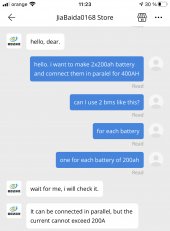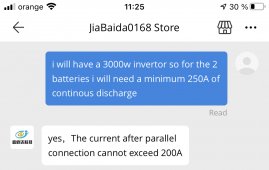Off Gridin' It
New Member
- Joined
- Dec 11, 2020
- Messages
- 102
I am about to begin a battery build. I have eight 280ah Lishen EVE Cells on the way.
I am trying to decide if I should build two 280ah 12v battery packs or one 560 12v battery pack.
The reason i am conflicted is the loads i am putting on this in regards to choosing the BMS.
I have a completely off grid 21.5 ft camper with a 1200 watt array going to a 100 Amp Renogy Charge Controller and also a 500 watt ground deploy array going to a 50 amp Victron charge controller For a total of 1700 watts.
Currently i have 800 ah (400 usable) of Deep Cycle Hybrid Gel batteries installed and this new pack will replace the GELS.
I run the entire camper off this system including the 13,500 BTU air conditioner.
I have a 4000 Watt AIMS inverter charger with a 12000 watt surge.
So i need your thoughts on this. With a 4000 watt inverter and taking into account the efficiency loss of the inverter I need a pretty large BMS.
4000 watts ÷ 12 volts = 333.33 amps
333.33 amps x 1.20 (efficiency loss) = 399.99 (Round to 400 amps).
So would it be best to run a 12 volts 560ah battery with a 500 amp Daly BMS or should i go with two 280 ah batteries each with there own 250amp BMS?
It has to be 12 volts. I am not switching out components to change over to 24 volts so please don’t suggest going 24 volts.
that do you all think?
I am trying to decide if I should build two 280ah 12v battery packs or one 560 12v battery pack.
The reason i am conflicted is the loads i am putting on this in regards to choosing the BMS.
I have a completely off grid 21.5 ft camper with a 1200 watt array going to a 100 Amp Renogy Charge Controller and also a 500 watt ground deploy array going to a 50 amp Victron charge controller For a total of 1700 watts.
Currently i have 800 ah (400 usable) of Deep Cycle Hybrid Gel batteries installed and this new pack will replace the GELS.
I run the entire camper off this system including the 13,500 BTU air conditioner.
I have a 4000 Watt AIMS inverter charger with a 12000 watt surge.
So i need your thoughts on this. With a 4000 watt inverter and taking into account the efficiency loss of the inverter I need a pretty large BMS.
4000 watts ÷ 12 volts = 333.33 amps
333.33 amps x 1.20 (efficiency loss) = 399.99 (Round to 400 amps).
So would it be best to run a 12 volts 560ah battery with a 500 amp Daly BMS or should i go with two 280 ah batteries each with there own 250amp BMS?
It has to be 12 volts. I am not switching out components to change over to 24 volts so please don’t suggest going 24 volts.
that do you all think?




